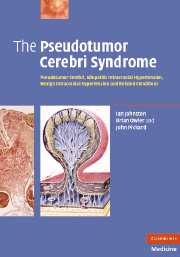 The Pseudotumor Cerebri Syndrome
The Pseudotumor Cerebri Syndrome Book contents
11 - Conclusions
Published online by Cambridge University Press: 21 August 2009
Summary
Historical background
PTCS has been a well-recognized and clearly defined nosological entity for over a century despite its rather bewildering array of names. The two developments which were particularly instrumental in its identification were the invention of the ophthalmoscope by von Helmholtz and the introduction of lumbar puncture by Quincke. Although it has become conventional to date the recognition of the syndrome from the reports by Quincke and Nonne between 1893 and 1914, there were clearly other, and perhaps more precise, descriptions that antedated the reports of the two German neurologists. Three salient features which emerge from the historical survey in Chapter 2 are:
A consistent and readily recognisable clinical picture has existed throughout the period from Quincke and Nonne to the present, although it has often been described, with good reason, as a diagnosis of exclusion.
A definite group (albeit an expanding one) of causative factors has been identified, the main ones from the time of the earliest recognition of the syndrome itself.
It is a condition with a favourable outcome apart from the risk of the long-term adverse effects of papilloedema.
Mechanism of PTCS
What has been a problem is the failure to identify the basic mechanism of the condition, which has resulted in on-going difficulties with classification and nomenclature. The weight of evidence, as marshalled in Chapter 3, clearly favours the concept of PTCS as a disorder of CSF hydrodynamics, most probably of absorption, although questions do also remain regarding formation and circulation.
- Type
- Chapter
- Information
- The Pseudotumor Cerebri SyndromePseudotumor Cerebri, Idiopathic Intracranial Hypertension, Benign Intracranial Hypertension and Related Conditions, pp. 275 - 282Publisher: Cambridge University PressPrint publication year: 2007


